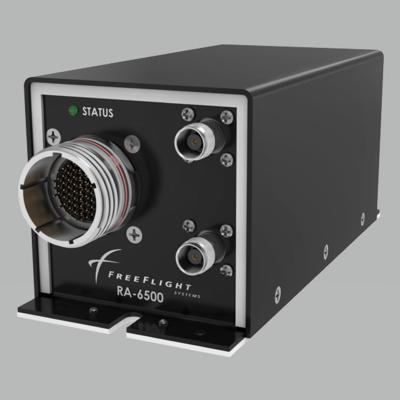Guidance for the Connected Age
The FAA has issued a Special Airworthiness Information Bulletin (SAIB) AIR-21-18R3.

Titled Risk of Potential Adverse Effects on Radio Altimeters, the document pertains to Radio Altimeters (RA) and the imminent debut of 5G wireless broadband networks across the United States and Canada.
Subject SAIB is informational in nature. Compliance with the recommendations set forth therein is prudent but wholly elective.
The SAIB states in part:
This Special Airworthiness Information Bulletin informs aircraft manufacturers, radio altimeter manufacturers, operators, and pilots of the continued deployment of wireless broadband networks in the 3.7-3.98 GHz bands (C-Band).1 C-Band wireless broadband deployment, which began in January 2022, is continuing to occur in phases for operations in the contiguous U.S. This SAIB recommends that radio altimeter manufacturers, aircraft manufacturers, and operators continue to voluntarily provide to federal authorities specific information related to altimeter design and functionality, specifics on deployment and usage of radio altimeters in aircraft, and that they test and assess their equipment in conjunction with federal authorities. Results from that testing and assessment should be reported to the appropriate civil aviation authorities (CAAs) and spectrum regulators. The FAA is collaborating with the Federal Communications Commission (FCC) and the National Telecommunications and Information
Administration (NTIA) to assess the need for mitigation beyond the recommended action in this SAIB and the required actions in airworthiness directives (ADs) addressing 5G C-Band interference on transport and commuter category airplanes and helicopters equipped with radio altimeters.

By dint of the 24 May SAIB, the FAA advised manufacturers of radio altimeters thus:
1. We request that radio altimeter manufacturers submit receiver radiofrequency (RF) selectivity, interference tolerance masks, and baseline operational specifications for each model number in production or still in use, and approximate numbers of each radio altimeter model currently in service in the United States; and, if appropriate, mark submissions as proprietary. This information can be submitted to the FAA at OperationalSafety@faa.gov and should indicate “Radio Altimeter SAIB” in the subject line. The FAA will provide any information you submit to the FCC and NTIA subject to those agencies’ processes for protection of confidential information, where such protection is requested.
2. We recommend radio altimeter manufacturers complete analysis or testing of each model number either in production, supported, or still being employed, to determine the susceptibility to interference from fundamental emissions in the full 3.7-3.98 GHz band, as well as potential spurious emissions in the 4.2-4.4 GHz band, and assess this susceptibility for compatibility with the adjacent spectrum environment in accordance with the FCC R&O and 3GPP specification, as well as the environment in other countries in which each radio altimeter could be operated. We encourage radio altimeter manufacturers to work with the FAA to facilitate this process.
3. Report instances of erroneous altimeter performance to the FAA and FCC, or other appropriate CAAs and spectrum regulators. If the equipment is susceptible to harmful interference, determine what design changes are necessary to remediate.
4. Collaborate with aircraft manufacturers on design changes and issue guidance to operators on potential retrofit plans for radio altimeters susceptible to harmful interference, if necessary.
5. Determine any necessary operational restrictions or actions needed to address in-flight radio altimeter anomalies in order to maintain safe operations with radio altimeter equipment susceptible to harmful interference and communicate this information to CAAs, operators, and pilots.
6. Collect radio altimeter retrofit plans, timelines, and completion information from operators and share this information with MITRE Corporation. MITRE will collect, aggregate, and de-identify proprietary information.
The FAA advised aircraft manufacturers:

1. We request that aircraft manufacturers submit approximate numbers of each radio altimeter model installed on each aircraft currently in service in the United States; and, if appropriate, mark submissions as proprietary. This information can be submitted to the FAA at OperationalSafety@faa.gov and should indicate “Radio Altimeter SAIB” in the subject line. The FAA will provide any information you submit to the FCC and NTIA subject to those agencies’ processes for protection of confidential information, where such protection is requested.
2. Communicate with radio altimeter suppliers and the FAA to ascertain equipment susceptibility to harmful interference caused by fundamental emissions in the 3.7-3.98 GHz band, as well as spurious emissions in the 4.2-4.4 GHz band. We encourage aircraft manufacturers to work with the FAA to facilitate this process.
3. Conduct testing and analysis of the effects of loss of function, and erroneous or misleading radio altimeter data from potential harmful interference caused by fundamental emissions in the 3.7-3.98 GHz band, as well as spurious emissions in the 4.2-4.4 GHz band, due to wireless broadband deployment. We encourage aircraft manufacturers to work with the FAA to facilitate this process.
4. Evaluate the potential for harmful interference on the different types of aircraft in the manufacturer’s fleet based on aircraft architecture and radio altimeter integration, including cascading effects.
5. Determine any operational restrictions necessary or actions to take to maintain safe operations with radio altimeter equipment susceptible to harmful interference due to wireless broadband operation in the 3.7-3.98 GHz band. Restrictions and other actions should address all systems that use the radio altimeter. Information regarding such restrictions or other actions should be communicated to operators, pilots, and each CAA for the country in which the aircraft operates. Revise aircraft flight manual procedures, if appropriate.
6. Update operators’ anomaly reporting process to ensure accurate recording and reporting of erroneous radio altimeter readings to the aircraft manufacturer.
7. Collaborate with radio altimeter manufacturers and issue guidance to operators on retrofit plans for radio altimeters susceptible to harmful interference due to wireless broadband operation in the 3.7- 3.98 GHz band. Collect radio altimeter retrofit plans, timelines, and completion information from operators and share this information with MITRE Corporation. MITRE will collect, aggregate, and de-identify proprietary information.
The FAA advised aircraft operators and pilots:
1. Review the 14 CFR Part 5 requirements for Part 121 certificate holders, if appropriate. Other certificate holders should use the Safety Management Systems (SMS) tools to assess the risk to each type of radio altimeter
2. Remind passengers that all portable electronic devices allowed for transport in checked baggage (including smartphones and other devices) should be turned off and protected from accidental activation and that compliance is mandatory for lithium battery-powered portable electronic devices. See 49 CFR 175.10(a)(18).
3. Remind passengers to set all portable electronic devices in the cabin and any carried on the aircraft to a non-transmitting mode or turn them off. See 14 CFR 91.21, 121.306, 125.204 and 135.144.
4. Seek information from the manufacturers of the aircraft and the radio altimeter on possible effects of harmful interference due to wireless broadband deployment in the 3.7-3.98 GHz band and possible pilot interventions. Provide radio altimeter retrofit plans, timelines, and completion information to your original equipment manufacturer and directly to the FAA at 9-AWA-AFS400- RADALT@faa.gov.
5. Operators should ensure their pilots are aware of the potential degradation of the radio altimeter capabilities and any means to compensate for in-flight radio altimeter anomalies. Consider both erroneous altimeter readings and loss of altimeter function.
6. Operators should ensure their pilots are aware of the potential degradation to the capabilities of safety systems and other equipment dependent upon radio altimeters and any means to compensate for resulting anomalies. Consider both the loss of function of the safety systems and other dependent systems and the manners in which they may malfunction.
7. Operators should consider the potential loss of pilot trust in dependent aircraft safety systems in the assessment of existing and the development of new crew procedures.
8. Operators and pilots who experience radio altimeter anomalies should notify air traffic control, as soon as practical. Post flight, pilots are encouraged to submit detailed reports of radio altimeter disruptions or interference events, as soon as practical, using the Radio Altimeter Anomaly Reporting Form available on the FAA website at https://www.faa.gov/air_traffic/nas/RADALT_reports/.
9. Coordinate with aircraft and radio altimeter OEMs to determine retrofit options that are available or under development and develop an implementation timeline that aligns with any applicable ADs.
 Classic Aero-TV: In Praise of Alabamas Patriot Aircraft USA
Classic Aero-TV: In Praise of Alabamas Patriot Aircraft USA NTSB Final Report: Cirrus Design Corp SR22
NTSB Final Report: Cirrus Design Corp SR22 ANN's Daily Aero-Term (12.21.25): Dead Reckoning
ANN's Daily Aero-Term (12.21.25): Dead Reckoning ANN's Daily Aero-Linx (12.21.25)
ANN's Daily Aero-Linx (12.21.25) Aero-News: Quote of the Day (12.21.25)
Aero-News: Quote of the Day (12.21.25)





